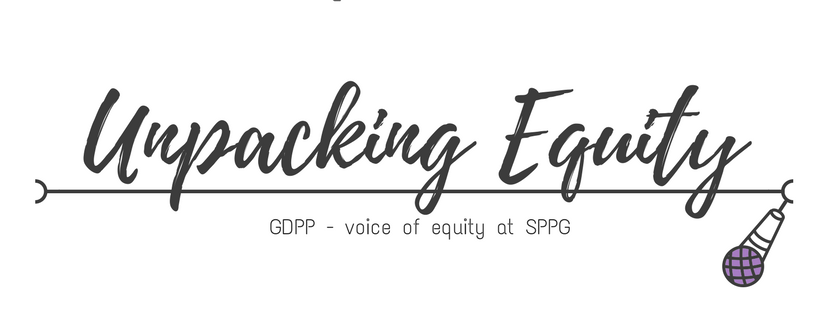 Unpacking Equity is a collaboration between the Public Policy and Governance Review and the Gender, Diversity and Public Policy Initiative (GDPP) at the School of Public Policy and Governance. This series aims to explain equity-related policy issues and break down complicated topics involving equity, diversity and inclusion. Policy professionals can gain a better understanding of these complex issues in order to incorporate an equity lens into their practice. To learn more, please get in touch with the GDPP.
Unpacking Equity is a collaboration between the Public Policy and Governance Review and the Gender, Diversity and Public Policy Initiative (GDPP) at the School of Public Policy and Governance. This series aims to explain equity-related policy issues and break down complicated topics involving equity, diversity and inclusion. Policy professionals can gain a better understanding of these complex issues in order to incorporate an equity lens into their practice. To learn more, please get in touch with the GDPP.
—
by Sharnelle Morgan
Over the last few years in Toronto, gender responsive budgeting has gained some traction. In July 2016, Toronto City Council approved a motion by Councillor Kristyn Wong-Tam to incorporate a gender equity perspective in all parts of the city budget process. Six months later, in January 2017, Councillor Wong-Tam held a town hall on gender responsive budgeting to foster discussion between experts and the public about how to make programs and services more equitable. However, according to critics, the city budget passed in 2017 failed to adopt a gender sensitive budget and as such, has had unfavourable effects on women. As policy enthusiasts watched deliberations over the 2018 city budget, gender responsive budgeting was once again in the news.
What is Gender Responsive Budgeting?
Gender responsive budgeting is a proactive measure that aims to address the specific needs of men and women by analyzing budgets from a gender perspective, allowing governments to re-think and understand finances in a new light.
Why has Gender Responsive Budgeting Become a Necessity for the City of Toronto?
Budgets are often mistakenly perceived as gender-neutral. However, evidence has shown that the allocation of funds can have different impacts on women and girls in comparison to men and boys. Budgets have been known to exacerbate gender inequalities rather than promote gender equality, and as such often work against the government’s own equity and diversity commitments. By analyzing public expenditure through a gender lens, the city can adjust its priorities and ensure that resources are allocated in ways that address gender inequalities.
Why is Gender an Issue in Public Expenditure?
Public expenditure, as stated by the World Bank’s M.Elena Ruiz Abril, is a “policy statement reflecting the government’s social and economic priorities and the fulfillment of its political commitments, in monetary terms, to specific policy and programs.” Embedding equity considerations in the city’s budget can provide information and data that help improve services and programs, and the information and data can also support evidence-based decision-making. As outlined in a briefing note on the subject written by city staff, the failure to include a gender lens in budgets results can have economic costs related to productivity levels, human resources, health impacts and reliance on social supports and programs.
Child care provides an example of an issue where gender-sensitive budgeting is relevant. In an article in the Huffington Post, Councillor Wong-Tam notes that Toronto has the most expensive childcare program in the country and among 35 peer nations as indicated in a 2016 OECD report. Toronto’s high childcare cost disproportionately affects and systematically disadvantages women, who often act as primary caregivers for their children. Currently, there are a 133,000 children living in poverty in the city of Toronto, and without regard to sensitive budgeting through programs and services such as affordable housing and access to child care, the City is at risk of increasing its issues of inequality and child poverty.
What can Torontonians expect in 2018?
To date, the city has taken several steps to incorporate an equity analysis into the 2018 city budget. The city developed an equity lens tool for budget planning and directed all programs and agencies to use the tool for all efficiency and service level changes. In order to measure the effectiveness of the tool, the city has made efforts to incorporate an equity impact assessment into the City’s budget, create an external review panel to review the equity impact analysis, and create a staff working group to review the application of the Equity Lens for the 2018 Budget and to explore ways of improving and extending the initiative for 2019.
Moreover, as part of the 2018 preliminary Operating Budget, the City highlighted four proposals aimed to address the City’s most prevalent equity issues. The proposals include improving access to child care and city services, and to expand dental care for adult recipients of Ontario Works. The proposals also included increased access to affordable housing through the Municipal Licensing & Standards’ proposal to regulate short term rentals in hopes of limiting the housing instability experienced by vulnerable groups.
For the city of Toronto, a large part of 2017 was spent actively developing tools to effectively implement the new gender-responsive budget. There have been many success stories of countries that have implemented a gender-responsive budget such as Morocco and Sweden and are using public expenditure to work towards a fair and equitable society. Although the 2018 budget has just begun, the City will be under critical evaluation to see if Toronto can also benefit from a budget that takes gender into account.
—
Sharnelle Morgan is a 2019 Master of Public Policy Candidate at the University of Toronto’s School of Public Policy & Governance and holds a Bachelor of Public Affairs and Policy Management specializing in Development studies from Carleton University. Her main policy interests include international development, race relations, education policy, and economic policy.